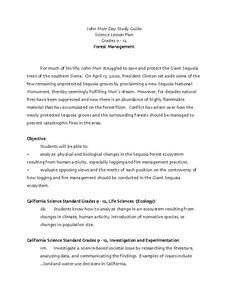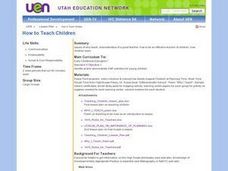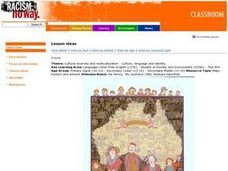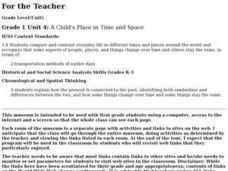Curated OER
Forest Management
Learners explore the changes in the Sequoia forest ecosystem. They evaluate reasons for the changes and discuss opposing views of human activity, logging and fire management practices. Students observe a video, describe the location of...
Curated OER
Science Happens in a Social Context
Students discuss how the same data is viewed differently between historians and scientists. Using the data, they compare and contrast the vocabulary used and the focus of attention. They analyze the conditions that help spread diseases...
Curated OER
Social Studies: How to Teach Children
Students examine reasons for teaching children and the characteristics of an effective teacher. After a Powerpoint presentation which includes a humorous look at the 1915 rules for teachers, they create daily teaching schedules and...
Curated OER
Internet Activity: More Space About Space
Learners analyze the exploration of space. In this space lesson, students discuss the space race of the 1950s and 1960s. Learners identify important events in space exploration and analyze the reasons for a space station.
Curated OER
Grain Properties Activity
Students study the similarities and differences of five different grains. They analyze the characteristics of corn, sunflower, milo, wheat, and soybeans.
Curated OER
Environmental Science/Water Pollution
Young scholars study natural habitats, aquatic life, renewable and non-renewable resources. They discuss conservation efforts for sea otters and desert toad in this units.
Curated OER
Ethics In The Science Classroom - Fraud In Science
Students are given a fictitious case study to read in preparation for the class. This lesson can also be readily adapted for a role-playing classroom exercise. They discuss the ethical issues of the case.
Curated OER
Science: Testing Water for Toxicity
Students investigate the potential toxicity of water samples using California blackworms to test water quality. They observe the worms' behaviors in different water samples and determine which sample has the highest toxicity. At the...
Curated OER
Social Studies: When Diseases become Epidemic!
Student participate in oral discussions to be able to define epidemic and identify 3 instances in history in which epidemics occurred. They are introduced to the quarter theme, disease. High schoolers identify disease as a crucial...
Curated OER
Social Studies: The Human and Animal Connection!
Students infer the connection among humans, animals, and disease through the interpretation of concept maps. They are introduced to the idea of a connection human disease and the domestication of animals.
Curated OER
Activity 10: Primary and Secondary Sources
Students sort documents into primary and secondary sources and analyze their reliability. In this history research lesson plan, the teacher gathers a selection of document images, then discusses primary and secondary sources and their...
Curated OER
Chinese Inventions A Selected History of Science and Invention in China
Students study the history of Chinese technology by identifying when and where items were invented or discovered.
Curated OER
Product of the Future Activity
Students predict what computers, games, or products be like in 2030. They think about and design futuristic products.
Curated OER
Social Studies: Reasons Diseases become Epidemic
Students identify reasons diseases become epidemic and list them in web format. They explore additional questins to to better investigate the time periods mentioned: 14th century, America at contact and the Age of Industry.
Curated OER
"How to Think Like an Archaeologist" - Suggested Pre-Visit Activity For Historic Jamestown
Learners examine how archaeologists use artifacts to explore other people and their cultures. They discuss types of artifacts, analyze receipts for clues, and discuss how what the items bought reflect about people.
Curated OER
Social Studies: Exploring Japan
Fourth graders examine the culture and environment of Japan, beginning with a KWL chart. They use clay and cups of water to construct representations of the Japanese Islands. After designing flags representing farming and food, 4th...
Curated OER
Alphabet Letter a Or N Theme
Students draw a tree with acorns. They depict roots and an acorn in the soil to review plant growth and practice handwriting letter A or letter N in the writing lines. They cut an additional page for the mini-book to include the word...
Curated OER
Bouncing off the Wall
Students watch a video clips before problem solving the use of angles in real world situations. They problem solve using spatial reasoning while connecting math to a sports activity that investigates the path of a bouncing ball.
Curated OER
EARLY CIVILIZATIONS
Students compare and contrast the monuments of four ancient cultures and draw conclusions about the origins, construction, and purposes of these structures.
Curated OER
Racism No Way
Students explore different cultural influences and their contribution to Australian identities. They reflect on their own backgrounds and making links with their peers, reflect on our heritage. Students view My family- My Australia,...
Curated OER
Your identity, your heritage
Students list memorable moments fro childhood. They complete the worksheet "Your identity, your heritage." Students look a sites regarding genealogy and discuss information about their families' genealogy or heritage. Students visit the...
Curated OER
A Child's Place in Time and Space
First graders visit each room of an online virtual museum in order to study transportation in the United States through time.
Curated OER
Early Industrialization
Eighth graders analyze primary source documents emphasizing young people in factory labor (mill workers during 1840-1860). They study hours of labor, ages of laborers, reasons for working, and working conditions. They write a poem or song.
Curated OER
Late 19th Century U.S. Foreign Policy
Eleventh graders discover that many of the issues the United States faces today elicit the same type of political, philosophical and moral debate that has divided the country in the past.

























